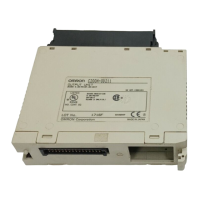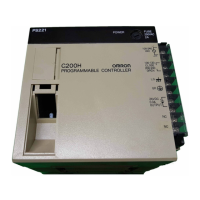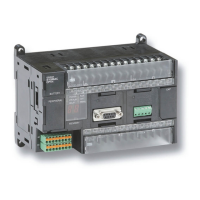129
7–5–2 Inputting or Overwriting Programs
Programs can be input or overwritten only in PROGRAM mode.
The same procedure is used to either input a program for the first time or to
overwrite a program that already exists. In either case, the current contents
of Program Memory are overwritten, i.e., if there is no previous program, the
NOP(00) instruction, which will be written at every address, will be overwrit-
ten.
To input a program, just follow the mnemonic code that was produced from
the ladder diagram, making sure that the proper address is set before start-
ing. Once the proper address is displayed, input the first instruction word,
press WRITE, and then input any operands required, pressing WRITE after
each, i.e., WRITE is pressed at the end of each line of the mnemonic code.
When WRITE is pressed, the designated instruction will be input and the next
display will appear. If the instruction requires two or more words, the next
display will indicate the next operand required and provide a default value for
it. If the instruction requires only one word, the next address will be dis-
played. Continue inputting each line of the mnemonic code until the entire
program has been input.
When inputting numeric values for operands, it is not necessary to input lead-
ing zeros. Leading zeros are required only when inputting function codes
(see below). When designating operands, be sure to designate the data area
for all but IR and SR addresses by pressing the corresponding data area key
or to designate a constant by pressing CONT/# . CONT/# is not required for
counter or timer SV (see below). TC numbers as bit operands (i.e., comple-
tion flags) are designated by pressing either TIM or CNT before the address,
depending on whether the TC number has been used to define a timer or a
counter.
The SV (set value) for a timer or counter is generally input as a constant, al-
though inputting the address of a word that holds the SV is also possible.
Inputting SV for Counters
and Timers
Inputting, Modifying, and Checking the Program Section 7–5

